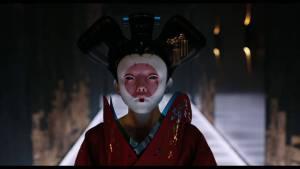
The ongoing argument about the need for more diverse representation in film or TV, both in front of and behind the camera, can sometimes seem academic or esoteric. One person rattles off the latest alarming static. Another person wags their finger at an especially egregious example of whitewashing.
Rinse. Repeat. Over and over again.
For those not personally impacted by the debate, we are probably far beyond the yawn, eye-roll phase of reaction and have officially moved on to "We're still talking about that?" annoyance. It's the inevitable life cycle of anything which either becomes politicized or has the appearance of having become politicized. See also: Trump supporters' ongoing indifference toward the Russia scandal.
I witnessed this very same non-reaction on Twitter yesterday when a headline about Paramount blaming Ghost in the Shell 's financial failure on whitewashing and bad reviews was greeted with, "Blah, blah, blah, whitewashing....this shit again? Find a new buzz word, Hollywood."
This illustrated to me that the debate about representation often fails to properly elucidate why exactly a lack of diversity is a bad thing. There's often an economic argument to be made, i.e., more and more women and minorities are buying movie tickets meaning it makes no sense to keep pretending as if the only audiences that matters are white males and the people in China. That line of thought is meant to speak to the film studios' bottom line, which is a language they understand. Plus, there's a common sense argument that a diverse workforce behind the scenes will translate to far more sophisticated movies and TV shows.
Yeah, but how? How would Ghost in the Shell have been improved by having some actual Asian people in positions of influence behind the scenes? Don't just say "they wouldn't have hired Scarlet Johansson" because, well duh. Give me something specific, but a little less obvious.
So glad you asked that, um, other me, because a recent HollywoodReporter chat with 4 Japanese actresses perfectly pinpointed multiple areas where the film's lack of diversity behind the scenes resulted in a culturally clueless movie, one which not only assigns a white face to a traditionally Japanese role but [ big spoilers from here on out] also then includes a third act twist which reveals our white cyborg hero (Johansson) and villain (Michael Pitt) both used to be Japanese before having their brains removed and placed inside cyborg bodies modeled after white people.
1. The Best of Human and Best or Robotics Has a White Face?
Keiko Agena ( Gilmore Girls): That was the other cringe-worthy moment, when they called each other by their Japanese names. We're looking at these beautiful white bodies saying these Japanese names, and it hurt my heart a little bit. As an acting challenge, I don't think there was anywhere for [Johansson] to go [with it], realistically. How do you really root down in the fact that you grew up Japanese and, when that moment hits you, not go funny or over the top?
Traci Kato-Kiriyama (PULLproject Ensemble): Probably ScarJo as a person didn't know that nuance. I'm not saying she had to have had this effusive, emotional physical outburst, but after you realize there's a Japanese brain in there somewhere, I didn't see any sort of reaction different from the rest of the movie.
Okatsuka: They didn't think about the depth that she'd have to go to understand that.
Kato-Kiriyama: It'd be such a great moment for the actor. But instead, it was just clueless.
Lesson: Don't bend over backwards to in-universe explain away the whitewashing inherit to your casting decisions. You actually ended up making it worse. Or, you know, just don't whitewash and put yourself in that mess in the first place.
2. A Japanese Mom Would Never Have Greeted a Complete Stranger Like ThatOkatsuka: Because I'm curious about the directing of certain moments. A Japanese mom, she wouldn't just let a stranger barge in.
Ai Yoshihara ( The Sea of Trees): And the last scene where the mom hugs her daughter at the grave, that was weird to me. Because Japanese people, we don't hug, especially mom's generation. Maybe an intense look instead.
Kato-Kiriyama (PULLproject Ensemble): They'd be crying. And they wouldn't be looking at each other, they'd be looking down.
Yoshihara: I was like, "No no no no no. We don't do that."
Lesson: If you're so desperate to reach the lucrative foreign markets maybe take a beat to actually run your material past some members in your core audience to see if it passes the smell test. They can tell you right away if something you've written will inspire reactions like "No no no no no. We don't do that." Or, you know, actually hire a writer who would already know that or do the necessary research to find out.
3. Where's the Shame Major Should Feel About Having Abandoned Her Mother?Okatsuka: You're supposed to connect with the fact that she hasn't seen her mom in a while. If she was a girl who grew up in Japan and ran away, first, she would feel shame, because she's Japanese. ( Laughter.)
Agena: Where was the shame in this movie?! There should have been a lot more shame.
Kato-Kiriyama: No eye contact! You're just staring at your mom's toes the whole time!
Lesson: Same as #2. Also, why not ask your actual Japanese actress if what the script calls for feels authentic?
4. Why Does Everyone Understand Japanese Even Though Only One Person Actually Speaks It?
Kato-Kiriyama: I think we're supposed to assume they have all these cool enhancements and you can understand any language.
Agena: So many assumptions being made! As an audience member, I am working too hard!
Yoshihara: Maybe his English was so bad that people didn't understand him.
Kato-Kiriyama: He's Beat Motherf-in' Takeshi. Let him speak Japanese.
Lesson: No one loves writing or saying them, but sometimes a simple line of exposition is a necessary evil to explain away obvious plot holes. Don't force your audience to connect all of the dots and make too many assumptions. Think of this as the Inception rule.
Of course, if you go too far you end up speaking down to your audience, but it should be obvious that one person speaking a different language from the rest of the cast even though everyone seems to understand him requires explanation. This might have been them attempting to partially make up for the whitewashing controversy by allowing Beat Takeshi to speak in his native tongue and generally be bad-ass, but if so it created yet another unforeseen problem.
5. What The Heck Is With All the Geishas?
Kato-Kiriyama: We're really convenient scenery. We're just the framing, the casing, and it's just so in-your-face. "And there's another koi fish, there's another geisha."
Yoshihara: The actress who played the mom played a madam in Memoirs of a Geisha, and when I saw that movie I knew she was directed by white directors because she was totally playing an American bitch. In Japan, we don't act like that. The demeanor and body language was mimicking an American person. Any time a white director directs a Japanese movie, they're always trying to get us to act American.
Lesson: You can't just throw koi fish ponds and geishas at something and call it authentic Asian scenery.

